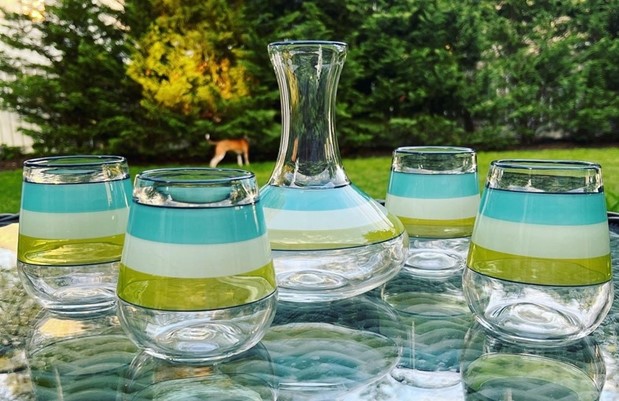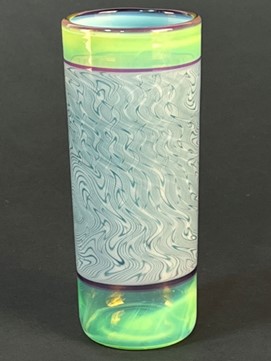 Reed Rogala of Wisconsin is a local glass maker that creates functional art. In the following article, Reed Rogala discusses the rich tapestry of glass art, unraveling its cultural meanings, symbolic interpretations, and enduring influence on modern culture and design.
Reed Rogala of Wisconsin is a local glass maker that creates functional art. In the following article, Reed Rogala discusses the rich tapestry of glass art, unraveling its cultural meanings, symbolic interpretations, and enduring influence on modern culture and design.
Glass, with its mesmerizing translucent properties and versatile malleability, has consistently fascinated both artists and artisans across the ages. Beyond its sheer practicality, it stands as a profound medium of expression, rich with cultural significance and symbolism that transcends geographical boundaries and historical epochs.
For centuries, artists have been drawn to the unique qualities of this material, harnessing its inherent luminosity and fluidity to create breathtaking works. From delicate stained-glass windows adorning ancient cathedrals to intricate sculptures gracing modern galleries, the versatility of glass as an artistic medium knows no bounds. Its ability to capture and refract light, coupled with its capacity to be shaped and molded into intricate forms, renders it an unparalleled tool for conveying complex emotions and narratives.
Moreover, Reed Rogala of Wisconsin explains that glass holds deep-rooted cultural significance in various societies around the world. Across different cultures and civilizations, glass has been revered as a symbol of purity, clarity, and transformation. In ancient Egypt, for example, it was associated with the divine, believed to possess mystical properties capable of warding off evil spirits and bringing blessings to its beholders. Similarly, in medieval Europe, stained-glass windows adorned churches and cathedrals, serving as visual narratives of religious stories and spiritual enlightenment.
Additionally, it has played a pivotal role in shaping historical trade routes and cultural exchanges. The Silk Road, for instance, facilitated the spread of glassmaking techniques and artistic styles across Asia, Europe, and the Middle East, fostering a rich tapestry of cross-cultural influences and innovations. As artisans and craftsmen exchanged ideas and techniques, the art of glassmaking evolved and flourished, giving rise to diverse traditions and schools of thought.
Reed Rogala on Contemporary Glass
In contemporary society, glass continues to hold a prominent place in the realm of art, design, and architecture. From sleek skyscrapers adorned with reflective facades to avant-garde installations exploring the interplay of light and space, glass remains a staple medium for pushing the boundaries of creativity and innovation. Its ability to seamlessly blend functionality with aesthetic appeal makes it an indispensable element in modern design, offering endless possibilities for architectural expression and artistic exploration.
In essence, this material transcends its utilitarian origins to become a potent symbol of human ingenuity, creativity, and cultural exchange. Reed Rogala says that whether as a vessel for artistic expression, a symbol of spiritual enlightenment, or a testament to technological innovation, glass continues to captivate and inspire generations of artists and audiences alike, forging connections across time, space, and culture.
Cultural Significance of Glass Art
Glass art has deep roots in various cultures across the globe, each infusing its own unique traditions, techniques, and symbolism into the craft. In Islamic art, for example, the intricate patterns and geometric motifs adorning glassware symbolize unity, harmony, and the divine order of the cosmos. Similarly, in Chinese culture, glass art has been revered for its auspicious symbolism, with delicate glass sculptures often featuring auspicious symbols of prosperity, longevity, and happiness.
In Western cultures, it has been synonymous with innovation and craftsmanship, with iconic glassmakers such as Louis Comfort Tiffany and René Lalique leaving an indelible mark on the art world. Their visionary creations, characterized by vibrant colors, organic forms, and intricate designs, continue to inspire contemporary glass artists and enthusiasts worldwide.
 Symbolism in Glass Art
Symbolism in Glass Art
Beyond its cultural significance, glass art is laden with symbolic meaning, with each piece telling a story, conveying emotions, or reflecting the artist’s vision. The transparency of glass symbolizes clarity, truth, and openness, inviting viewers to peer into the depths of the artwork and explore its hidden depths.
Reed Rogala of Wisconsin notes the fragility of the material serves as a poignant metaphor for the delicate balance of life, reminding us of the ephemeral nature of existence and the importance of cherishing each moment. Conversely, the resilience of the material, forged through fire and shaped by skilled hands, represents strength, resilience, and the transformative power of adversity.
Furthermore, the reflective properties offer a metaphorical mirror through which viewers can introspect and contemplate their own reflections, prompting deeper insights into the human experience and the interconnectedness of all things.
Glassware in Modern Culture and Design
In addition to its artistic significance, glassware plays a pivotal role in modern culture and design, shaping our daily interactions, rituals, and aesthetics. From the sleek lines of minimalist pieces in contemporary interiors to the ornate crystal chandeliers adorning opulent ballrooms, artifacts imbue spaces with elegance, sophistication, and style.
Reed Rogala specializes in products like stemless wine glasses and decanters, their creations are crafted to withstand extreme temperature changes, providing exceptional durability, and are dishwasher safe. Combining traditional techniques with contemporary aesthetics, these pieces embody a seamless fusion of heritage and innovation.
Moreover, Reed Rogala of Wisconsin says that these products serve as a vessel for culinary creativity, enhancing the presentation and enjoyment of food and beverages, and the choice of vessels can elevate the dining experience and evoke a sense of luxury and refinement.
Glass in Architecture
In the realm of architecture, glass has emerged as a defining element in modern design, with sleek facades and soaring skyscrapers symbolizing progress, innovation, and urban sophistication. The transparency of this material allows natural light to flood interior spaces, creating a sense of openness and connection with the surrounding environment.
Conclusion
As we navigate the intricate landscape of glass art and design, we are reminded of its enduring allure and multifaceted significance in shaping our cultural heritage and collective consciousness. From its ancient origins to its modern manifestations, this material continues to captivate and inspire, transcending barriers of time, culture, and geography.
In its myriad forms, glass serves as a canvas for artistic expression, a symbol of cultural identity, and a cornerstone of modern design. As we contemplate the beauty and symbolism inherent in glass art, let us cherish its timeless legacy and celebrate the artisans who continue to push the boundaries of creativity and craftsmanship in this captivating medium of expression.


